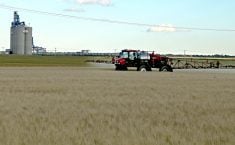NANZHENCUN, China – Duck breeder Chen Huaping thinks Severe Acute Respiratory Syndrome, as flu-like infections go, is mere chicken feed.
Last October, he witnessed the wrath of bird flu first hand when a freshly bought yellow duckling dropped dead in his backyard 30 kilometres outside the southern Chinese city of Guangzhou.
Within a week, the disease had wiped out 300 of his 500 baby ducks.
“I took the body to a veterinarian and he said, ‘If they catch a flu, you might as well just let them die off. You can’t cure it.’ When they die, they die fast.”
Read Also

New coal mine proposal met with old concerns
A smaller version of the previously rejected Grassy Mountain coal mine project in Crowsnest Pass is back on the table, and the Livingstone Landowners Group continues to voice concerns about the environmental risks.
No need to tell that to breeders devastated by avian flu this winter in South Korea, Japan and most alarmingly, Vietnam, where the World Health Organization recently confirmed that the disease had hurdled the species barrier and killed at least three people.
Chen boasts that he has never fallen sick on his farm, but his lifestyle is the sort that makes epidemiologists cringe.
He lives beside a mucky pond in a tree bark cabin abutting a corrugated steel shelter, where the ducks waddle up the banks to feed and scatter their droppings on the way down.
Small farms like his, squalid and teeming with fetid animals, are widely believed to make southern China and other densely populated areas across Asia cauldrons for lethal new flu strains.
SARS, the flu-like illness that first swept out of Guangdong last year to kill 800 people around the world, was only the latest warning sign.
In response to new suspected cases, Guangdong has declared war on the civet cat and similar species, based on laboratory evidence that they harbour a coronavirus similar to the SARS pathogen. Rats, meanwhile, are the target of a spring clean-up drive.
But the rural breeding grounds for mutant flu offshoots have not changed.
Scientists, though often stymied in their attempts to connect the dots, commonly point to a triangle of contagion linking man, bird and swine.
As the theory goes, viruses of farmers and fowl may mingle or trade genes. An avian flu byproduct can then incubate in pigs, which in turn reinfects humans.
Farmers and traders go on to mix with city folk who hop the globe by jet, while trucks haul their teeming flocks to faraway locales. Thus the scale of disease mushrooms.
“A pandemic influenza is certainly much bigger than SARS,” said microbiologist Malik Peiris, a SARS expert at the University of Hong Kong.
The prospect of the next big pandemic haunts southeast Asia.
Asian flu in 1957-58 and Hong Kong flu in 1967-68 killed 4.5 million people combined.
Scientists in recent years have even traced the 1918-19 Spanish flu pandemic, in which 40-50 million people perished, back to southern China.
Doctors emphasize that Guangdong, home to 90 million people, is but one of many places where new viral diseases may emerge. The deadly West Nile and ebola viruses broke out in Africa.
“But what is unique in the southern China region or that part of Asia is the live animal market scenario,” Peiris said.
“They can exchange viruses, they can amplify within those markets and you have humans coming into repeated contact with animals, a wide diversity of people.”
The most vulnerable may not be farmers or traders. SARS studies have revealed a relatively high infection rate among food industry workers, who tend not to be as exposed.
This month’s civet cull marked what many observers consider the first serious crackdown on unhygienic markets in Guangzhou. Many experts said it was long overdue.
Now one big question is how far the government can go in tidying up the animal husbandry business without stripping people of their livelihoods. Another is whether the cleanup can even work as long as people and animals live in close quarters.
At Guangzhou’s high-profile Xin-yuan bird and livestock market re-cently, there were more government inspectors than customers.
The hawkers, huddled next to cages of rabbits and dogs crammed ear-to-jaw, roundly denied any on-the-job hazards.
Most markets probably face the long-term prospect of strict inspections rather than closure, local media suggested.
Bird flu last wreaked havoc in the region in 1997, when six people died in neighbouring Hong Kong.
Guangdong agricultural officials say their early warning systems are armed to catch diseases like avian flu.
“I would say with respiratory disease in general, Guangdong province is fairly clued in and ready to detect anything that would come along,” said WHO expert Jeffrey Gilbert.
But no one from local quarantine stations ever visited Chen’s farm. He had never considered using vaccines.
Now, since the plague that struck his ducklings, Chen has sworn by a common vaccine, which costs $6 US for 500 doses worth of the concoction, as thick as rubber cement.
It may help protect Chen from bird flu, but not from other new strains. “Some of these viruses that can jump across to humans may not be even recognized as being significant animal pathogens,” Peiris said.
Ideally, Chen would build some distance between him and his ducks, but he insists monster rats would have a feeding frenzy at night if he lived any further away.
One answer might be for his boss to erect a duck island in the middle of the pond.
“Maybe that would be more sanitary. They would not have to step in their own dung.”
















